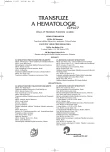Quality parameters of cryopreserved red cells reconstituted in AS-3 solution (Nutricel)
Authors:
M. Bohoněk 1; M. Petráš 1; I. Turek 1; J. Urbanová 1; T. Hrádek 1; V. Staropražská 1; J. Koštířová 1; D. Horčičková 1; S. Duchková 1; J. Svobodová 2; E. Tejčková 2
Authors‘ workplace:
Oddělení hematologie, biochemie a krevní transfuze, Ústřední vojenská nemocnice, Praha
1; Oddělení nukleární medicíny, Ústřední vojenská nemocnice, Praha
2
Published in:
Transfuze Hematol. dnes,12, 2006, No. 4, p. 208-216.
Category:
Comprehensive Reports, Original Papers, Case Reports
Overview
The article summarised partial results the project of evaluation and implementation method for collection and longterm storage packed red cells (RBC) for strategic, special and therapeutic findings Army of Czech Republic as well as the country. The essential surveyed method was freezing of RBC collected by double erythrocytapheresis in high glycerol at -80 °C and stored at -65 °C and lower. Glycerolisation, deglycerolisation and resuspension in Nutricel (AS- 3) was performed with the Haemonetics ACP 215 machine by closed system. Stability of RBC in AS-3 was evaluated by clinical study with health volunteers by index of therapeutic effectiveness (ITE) as well as by biochemical and haematological parameters. Reconstituted RBC units were evaluated in days 0,7,47 and 21 after thawing by 51Cr labelled red cells in two groups: freezing and storage in primary collection bags (group A) and freeing and storage in special bags for deep freezing (group B). 24-hour survival autologous red cell at health volunteers were observed and set ITE and via “freeze-thaw-wash-recovery” (FTW%) dependent on amount of haemoglobin in waste after washing deglycerolised RBCs. Totally 104 RBC units were frozen, reconstituted and measured. Evaluated RBCs both groups were almost statistically identical ITE: 74.01 (±CI95%: 71.97–76.04), 74.02 (±CI95%: 71.18–76.87) and 74.5 (±CI95%: 71.62–77.38), respectively, regardless of storage time after RBCs deglycerolization. The 4-percent decrease of 24-hour posttransfusion survival (%) means as well as 4-percent increase of FTW% means were statistically significant between RBCs group B and A. Haemolysis in the end of storage was below 1% at both group. From haematological and biochemical parameters haemoglobin, haematocrit, leucocytes, haemolysis, osmolality, pH, potassium, phosphorus, ATP, ammoniac and 2,3-DPG were observed. Results of these tests demonstrate good applicability frozen RBC 3 week after thawing and reconstitution in Nutricel and following storage at 2–6 °C.
Key words:
cryopreservation of red cell, deep frozen blood, reconstitution, glycerolisation, deglycerolisation, crisis blood policy, Nutricel, AS-3, double erythrocytapheresis
Labels
Haematology Internal medicine Clinical oncologyArticle was published in
Transfusion and Haematology Today

2006 Issue 4
Most read in this issue
- Computer crossmatch - performance, validation and first implementation in the Czech Republic
- Significance of immunotherapy with anti-CD20 rituximab and high-dose chemotherapy with autologous peripheral blood stem-cell transplantation in first-line treatment for mantle-cell lymphoma – centre experience
- Quality parameters of cryopreserved red cells reconstituted in AS-3 solution (Nutricel)
- Evaluation of antigen-specific lymphocytes anti-tumour effect with use of non-radioactive cytotoxicity test
